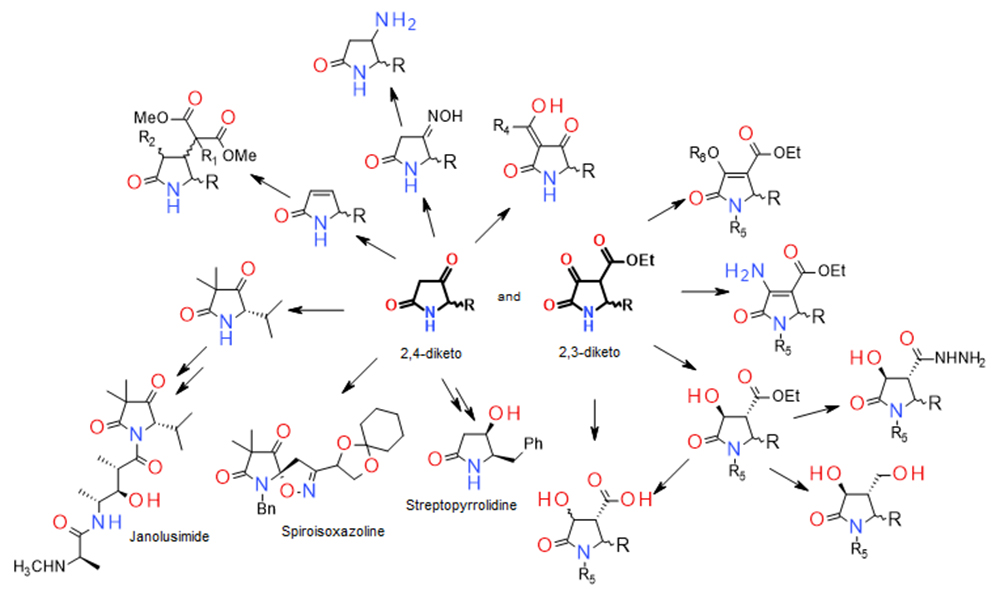Organic Synthesis Research Group
Organic Synthesis Research Group concentrates on creating and understanding new molecules, which will lead to the discovery of new or refined drugs as well as novel and potential organocatalysts. The research group focuses in the research area of organic chemistry namely development of synthetic methodology, in addition to structural exploration and synthetic studies of some nitrogen heterocycles with a pyrrolidine ring system such as proteasome inhibitor lactacystin, hypotensive drug codonopsinine, lipophilic neurotoxin janolusimide and angiogenesis inhibitor streptopyrrolidine. By means of 2,3- and 2,4-pyrrolidinedione intermediates, the group concentrates on synthesizing lactone-lactam and lactam-lactam bicyclic systems which are highly likely to be important precursors towards the development of pharmaceutical agents. A research on potential organocatalysts which revolves around not only environment-friendly catalysts but also pyrrolidinium type ionic liquids are also being explored based on previous knowledge of the chemical properties of the pyrrolidine ring moiety.

The Organic Synthesis Research Group has assisted Sime Darby Research Sdn Bhd in developing derivatives of L-quebrachitol which include mannitol, inositol and inositol triphosphate, with potential confectionery and pharmaceutical values. Recently, it has secured a research grant under the Transdisciplinary Research Grant Scheme (TRGS) with the research teams from iPROMISE UiTM developing strategies in generating and investigating potential multi-target inhibitors with derivatives of chalcones and flavones for targets related to inflammation; this collaborative effort is therefore hoped to eventually develop leads in drug discovery. The Organic Synthesis Research Laboratory is equipped with Nuclear Magnetic Resonance Spectroscopy (NMR) and High Resolution Mass Spectroscopy (HRMS) and the group has continually exercised collaboration with other research teams within as well as outside the university and provides capacity building for potential organic chemists.
Microbiology and Drug Discovery Group
The areas of research interests in this group are listed below:
1. Bacteriophages as bio-controls agents
Bacterial viruses are the natural predators of bacteria and thus are promising candidates as bio-control agents for infectious diseases. The research in this area focuses on bacteriophages as bio-controls for plant pathogens and antibiotic resistant bacteria.
2. Extensively drug resistance in nosocomial pathogens
The mechanisms of extensively drug resistance in nosocomial pathogens such Acinetobacter baumanii, Acinetobacter calcoaceticus, Enterobacter cloacae, Klebsiella pneumoniae and Pseudomonas aeruginosa are of interest. The prevalence of metallo-beta lactamase and extended spectrum beta lactamase genes, plasmid carriage and the involvement of efflux pumps are among the projects currently undergoing.
3. Molecular typing
Molecular typing of plant pathogens and extensively drug resistance bacteria are being carried out to study variations in the pathogenicity, virulence, clonality of individual strains within a species and to and to monitor the reservoirs of epidemic organisms.
4. Development of loop mediated amplification method for detection of plant pathogens
In the last decade, Loop-mediated amplification (LAMP), is becoming increasing popular for detection of plant pathogens. First described in 2000, this method achieves gene amplification isothermally and without requiring denaturation of the template DNA. The simplicity of the LAMP method, which does not require a thermal cycler, makes it suitable for field-testing. In this laboratory we are currently developing this method to detect blood disease bacterium of banana.
5. Drug Discovery
New antimicrobials are prospected in endophytic, epiphytic and marine bacteria. This also includes investigating the presence of quorum sensing inhibitors from the above mentioned organisms and in medicinal plants.
Drugs with neuroprotection activities are also being prospected from marine organisms and natural products.
